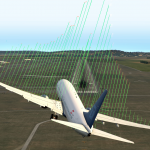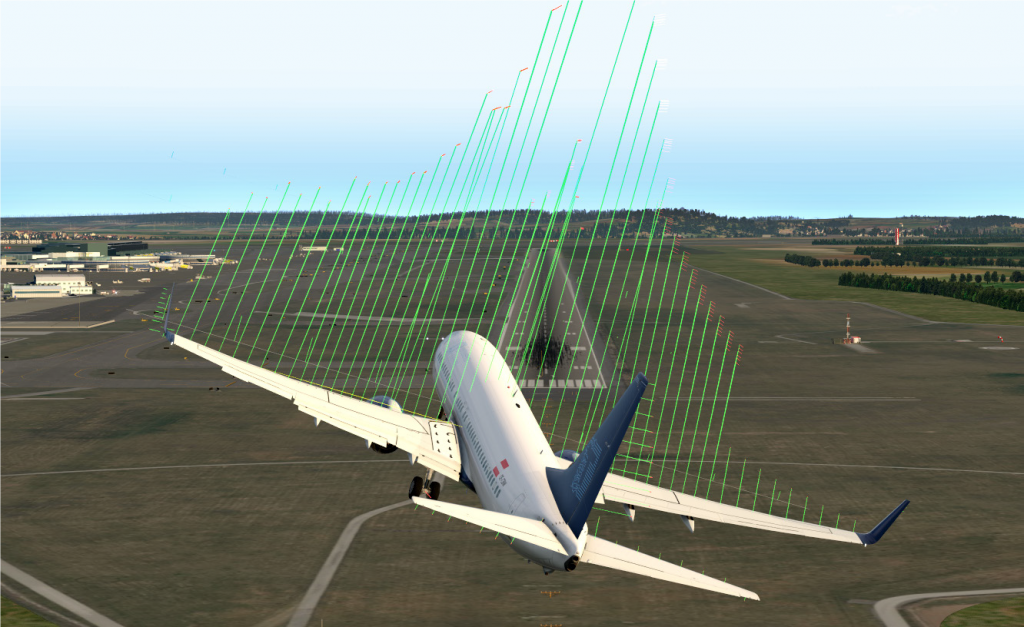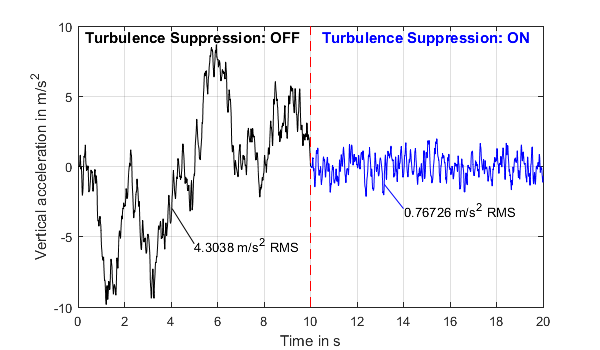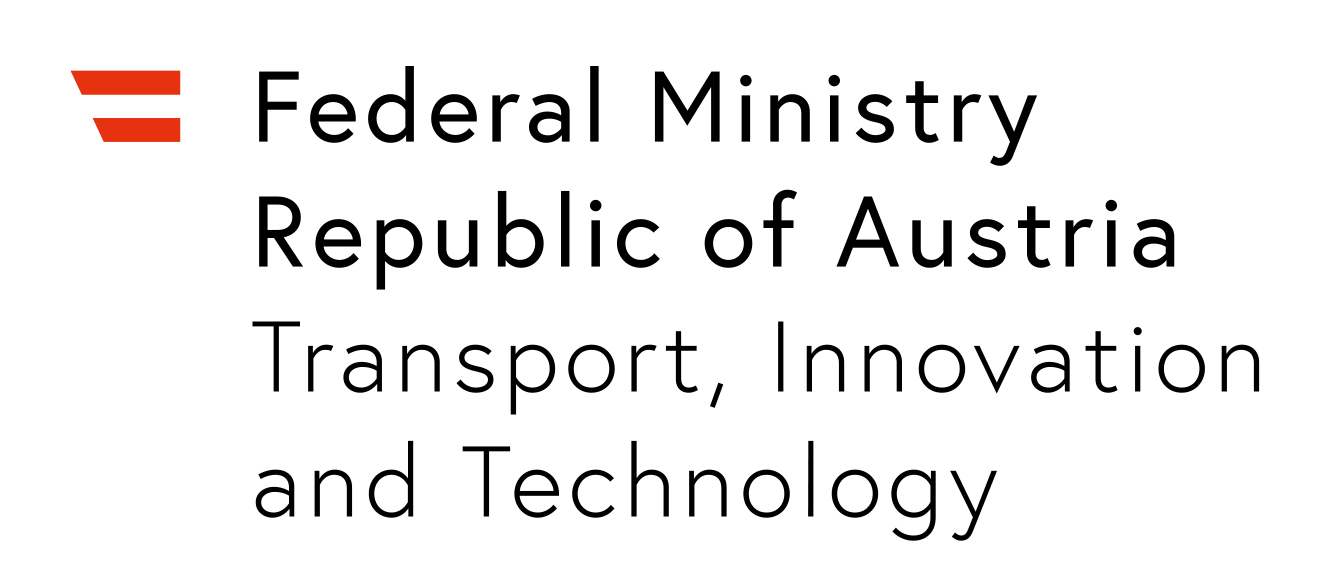
Active Turbulence Suppression for Aircraft – SmartWings
Atmospheric turbulence is an unsolved problem for aviation impairing economy, safety and comfort. Current efforts to predict turbulence more accurately in order to avoid it by rerouting result in higher fuel consumption and CO2 emissions as well as reduced traffic volumes.

Approaching aircraft in atmospheric turbulence – visualization of local lift distribution and drag
Objective
In the future it should be possible to fly through atmospheric turbulences directly and reliably. The SmartWings research project at ACIN is investigating methods and technologies that are able to reduce the disturbance effects of turbulence, such as vertical accelerations, by as much as 80%.

Störbeschleunigung eines Flugzeugs in atmosphärische Turbulenz ohne und mit Turbulenzunterdrückung
Approach
Smart wing structures measuring turbulences in front of the wing and actively adjusting their shape can suppress disturbance effects of atmospheric turbulences in flight. Calculating optimum flight control outputs from the measured data is a particular control engineering challenge. It is solved by a combination of model-based feedforward and feedback control.
Highly dynamic lift control: Through the application of direct lift control, the wing lift can be varied very quickly. A novel control procedure prevents secondary short-period oscillation and thus considerably increases the lifting effect that can be achieved.
Phase compensation: Using anticipating sensors, such as pressure measurements in front of the wing or wind LiDAR, it is possible to compensate system-related time delays and the disturbances precisely at the right moment.
Adaptive structures: Innovative materials and manufacturing methods enable the use of adaptive wing structures (morphing wings) in order to adapt the wing shape specifically to the external flow field.
Applications
Active Turbulence Suppression may be applied to fixed-wing airplanes of different sizes – from micro UAV to long-haul aircraft. An essential prerequisite for implementation is a digital flight control and technical equipment on the wing in order to vary the lift quickly. For this purpose, conventional wing flaps or, in the future, novel wing structures with adaptive elements may be used.
Related Publications
Journal articles
- A. Galffy, R. Gaggl, R. Mühlbacher, D. Frank, J. Schlarp, and G. Schitter, Turbulence load prediction for manned and unmanned aircraft by means of anticipating differential pressure measurements, CEAS Aeronautical Journal, vol. 12, 2021.
[BibTex] [Download]@article{TUW-292332, author = {Galffy, Andras and Gaggl, Rainer and M{\"u}hlbacher, Robert and Frank, Daniel and Schlarp, Johannes and Schitter, Georg}, title = {Turbulence load prediction for manned and unmanned aircraft by means of anticipating differential pressure measurements}, journal = {CEAS Aeronautical Journal}, year = {2021}, volume = {12}, doi = {10.1007/s13272-021-00512-y}, keywords = {atmospheric turbulence, disturbance prediction, turbulence suppression, gust load alleviation} }
- A. Galffy, M. Böck, and A. Kugi, Nonlinear 3D path following control of a fixed-wing aircraft based on acceleration control, Control Engineering Practice, vol. 86, p. 56–69, 2019.
[BibTex] [Download]@article{TUW-278869, author = {Galffy, Andras and B{\"o}ck, Martin and Kugi, Andreas}, title = {Nonlinear 3D path following control of a fixed-wing aircraft based on acceleration control}, journal = {Control Engineering Practice}, year = {2019}, volume = {86}, pages = {56--69}, doi = {10.1016/j.conengprac.2019.03.006} }
Conference papers
- A. Galffy, J. Schlarp, D. Frank, R. Mühlbacher, and G. Schitter, Turbulence prediction for aircraft by means of high-dynamic differential pressure measurements, in Proceedings of the Aerospace Europe Conference AEC2020, 2020.
[BibTex] [Download]@inproceedings{TUW-292322, author = {Galffy, Andras and Schlarp, Johannes and Frank, Daniel and M{\"u}hlbacher, Robert and Schitter, Georg}, title = {Turbulence prediction for aircraft by means of high-dynamic differential pressure measurements}, booktitle = {Proceedings of the Aerospace Europe Conference AEC2020}, year = {2020}, keywords = {atmospheric turbulence, disturbance prediction, turbulence suppression, gust load alleviation}, note = {Vortrag: Aerospace Europe Conference AEC2020, Bordeaux, France; 2020-02-25 -- 2020-02-28} }
- A. Galffy, F. Car, and G. Schitter, Calibration and flight test of a 3D printed 5-hole probe for high-dynamic wind measurements for UAV, in Proceedings of the International Workshop on Research, Education and Development on Unmanned Aerial Systems, 2019.
[BibTex] [Download]@inproceedings{TUW-282543, author = {Galffy, Andras and Car, Florian and Schitter, Georg}, title = {Calibration and flight test of a 3D printed 5-hole probe for high-dynamic wind measurements for UAV}, booktitle = {Proceedings of the International Workshop on Research, Education and Development on Unmanned Aerial Systems}, year = {2019}, numpages = {10}, doi = {10.1109/REDUAS47371.2019.8999671}, note = {Vortrag: International Workshop on Research, Education and Development on Unmanned Aerial Systems, Cranfield, United Kingdom; 2019-11-25 -- 2019-11-27} }
Project Partners
Turbulence Solutions GmbH
T.I.P.S. Messtechnik GmbH
Actaron GmbH
Press Release
Funding
funded under the program Take Off of the Austrian Federal Ministry for Transport, Innovation and Technology (bmvit)


Contact
Univ.Ass. Dipl.-Ing. Andras GalffyUniv.-Prof. Dipl.-Ing. Dr.sc.techn. Georg Schitter
Project Staff
Univ.Ass. Dipl.-Ing. Andras GalffyAssociate Prof. Dipl.-Ing. Dr.techn. Ernst Csencsics
Stefan Teller
Daniel Frank
Florian Car